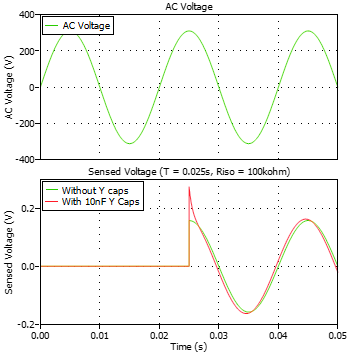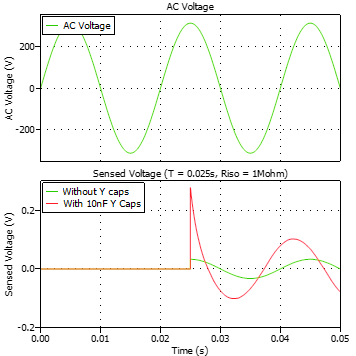SLUAB09 October 2025 AMC0386-Q1 , TPS61170 , TPS61170-Q1 , TPSI2140-Q1
1.3.1 Influence of Y-Capacitors
The AC side of the onboard charger (OBC) typically incorporates a two?stage EMI filter, and a Y?type capacitor as a key element of that filter. In a V2L scenario, an external load is also equipped with an individual EMI filter on the load?side, adding further Y?capacitance to the circuit. Because the value of the Y?capacitor of the load is not known in advance, the combined capacitance can rise to as much as 100nF, which can significantly complicate the insulation-monitoring design.
The Y?capacitor influences the measurement in two ways, the capacitor introduces an error during transient periods and distorts the steady?state reading. Influence of Y-Capacitors illustrates a typical AC?voltage?sensing circuit. The waveform at the top shows the true AC voltage. In the lower panel, the green trace represents the voltage that is sensed if the Y?capacitor is ignored; whereas, the red trace shows the voltage that is actually sensed when the effect of the Y?capacitor is considered.
Influence of Y-Capacitors illustrates two distinct error mechanisms, introduced by the Y?capacitor, in the AC?voltage?sensing loop.
- Transient?state error (Figure 1-2): At the moment the measurement begins (t?=?0.025s), the capacitor must charge through the sensing resistor. During this charging interval, the measured voltage deviates from the true value; only after the voltage has settled does the reading become accurate.
- Steady?state error (Figure 1-3): Since the Y?capacitor presents a frequency?dependent impedance, the sensed waveform is phase?shifted with regard to the actual AC voltage. The sensed voltage leads the true voltage, and the phase lead grows with increasing capacitance.
Influence of Y-Capacitors
 Figure 1-2 Transient?State Error
Settling Time
Figure 1-2 Transient?State Error
Settling Time  Figure 1-3 Steady?State Error Phase
Delay
Figure 1-3 Steady?State Error Phase
DelayThe time constant (τ?=?R × C) governs the severity of both effects. A larger τ lengthens the charge?and?discharge periods, prolonging the settling time and amplifying the phase deviation. For a given Y?capacitance, reducing the resistance in the measurement network of the IMD (for example, lowering R) shortens τ, and therefore, improves measurement accuracy.